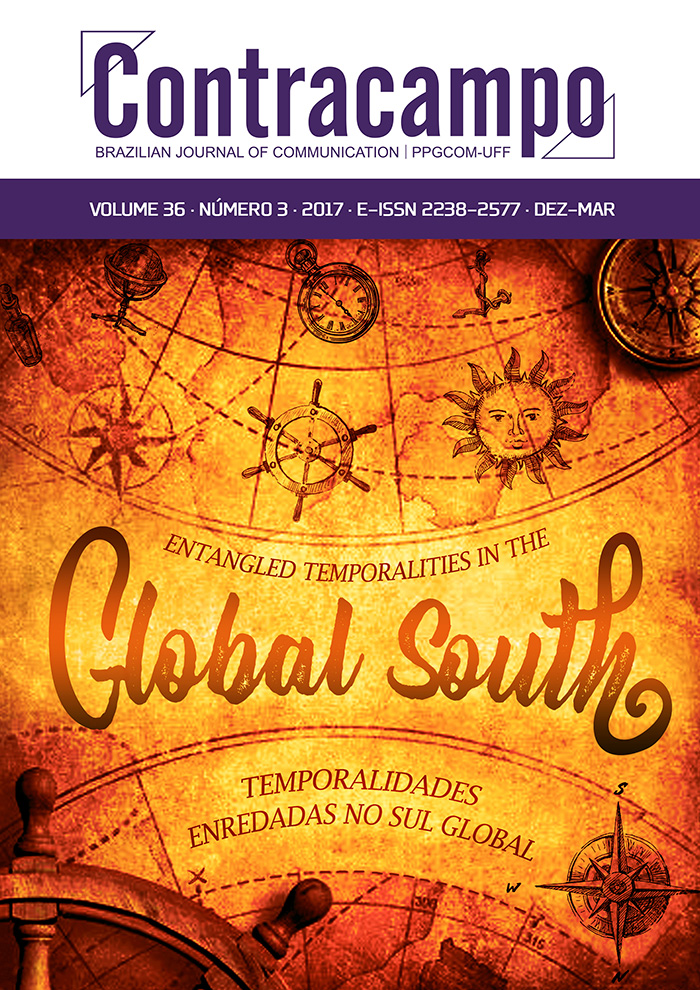On Seeing a Bull’s Skull in a Bicycle Seat: Innovative Archaism
DOI:
https://doi.org/10.22409/contracampo.v36i3.1043Resumo
How may indigenous practices from Oceania open up the possibility of a future occluded by the long epoch of surplus accumulation? This future is not unforeseeable, but rather one that co-exists as an impeded possibility in the present. The global South—whether as time, space, value or figure—inhabits the order of the non-synchronous and archaic vis-à-vis the global north as dictated by the normative law of surplus accumulation. In this paper I draw on Theodor Adorno’s insight concerning the co-presence of the archaic in the time of modernity to argue that the perspectival aspect of modernity is built on the act of looking at something while looking through it. In other words, seeing concerns the paradoxical act of not-seeing,of looking through some aspect or dimension of whatever one is looking at. If, however, silence were to discover speech, and we commenced to look at what we have been taught to look through, modernity starts to take on an altogether different aspect. The Global South of Oceania, in particular, turns into a region of innovative archaisms, counter-national imaginings, surplus-subverting practices and communal forms of ecological ethics. This paper contends that archaic indigenous practices, in concert with scientific knowledge, may be in advance of the modern in offering a pragmatic response to the climate-related crisis generated by modernity.
Keywords: Global South, Fiji, Oceania, Arcaism, Temporality.
Downloads
Referências
Adorno, T. W. & W. Benjamin (1999). The Complete Correspondence 1928-1940, H. Lonitz (ed.), Cambridge: Polity Press, 1999.
Aalbersberg B, A. Tawake & T. Parras (2005), Village by Village: Recovering Fiji’s Coastal Fisheries, World Resources 2005: The Wealth of the Poor, Washington DC: World Resources Institute, glispa.org/images/Papers/FijiCaseStudy.pdf
Blakelock, David (1976). ‘The Sacred Turtles of Kadavu,’ Pacific Islands Monthly, 47:1.
Bloch, Ernst (1977). ‘Nonsynchronism and the Obligation to Its Dialectics,’ New German Critique, 11, 22-38.
Bowden-Kerby, Austen (2003). ‘Community-Based Management of Coral Reefs: An Essential Requisite for Certification of Marine Aquarium Products Harvested from Reefs under Customary Marine Tenure,’ Marine Ornamental Species: Collection, Culture and Conservation, J.C. Cato & C.L. Brown (eds), Iowa: Iowa State Press, 139-166.
Brodsky, Joseph (2002). Collected Poems in English, New York: Farrar, Straus and Giroux.
Chappell, David A. (1997). Double Ghosts: Oceanian Voyagers on Euroamerican Ships, New York: M.E. Sharpe.
D’Arcy, Paul (2006). The People of the Sea: Environment, Identity, and History in Oceania, Honolulu: University of Hawaii Press.
Derrida, Jacques (1994). Spectres of Marx: The State of the Debt, the Work of Mourning and the New International. Peggy Kamuf (transl), New York: Routledge.
Geraghty, Paul (1993). ‘Pulotu, Polynesian Homeland,’ Journal of the Polynesian Society, 106: 4, 343-384.
Gilroy, Paul (1993). The Black Atlantic: Modernity and Double Consciousness. Cambridge, MA: Harvard University Press.
Guinea, Michael (1993). Sea Turtles of Fiji, South Pacific Regional Environment Programme Report, http://www.seaturtle.org/pdf/guineam_1993_spreptechreport.pdf
Hau’of, Epeli (1993). ‘Our Sea of Islands,’ A New Oceania: Rediscovering Our Sea of Islands, Suva: The University of the South Pacific, 2-16.
Helu, I.F. (1999), Critical Essays: Cultural Perspectives form the South Seas, Canberra: The Journal of Pacific History, 309-331.
Howard, Alan (1985). ‘History, Myth and Polynesian Chieftainship: The Case of Rotuman Kings,’ Transformations of Polynesian Culture, A. Hooper and J. Huntsman (eds), Auckland: Polynesian Society, 39-78.
Johnston, Ingrid (2016). Rebuilding Sustainable Communities after Disasters: Remote Islands, Newcastle: Cambridge Scholars.
O’Carroll, John (1997). ‘Multiple Cities: Suva and the (Post)colonial,’ Dreadlocks: In Oceania, 1,26-54.
Pule, John (1992). The Shark that Ate the Sun, Auckland: Penguin Books.
Reed, A.W. & I. Hamez (1967), Myths and Legends of Fiji and Rotuma, Auckland: Reed.
Schultz, Brian (2009). The Modernization of Fiji’s Food System and the Resulting Implications in Fijian Society, http://digitalcollections.sit.edu/isp_collection/681/
Thomas, Nicholas (2010). Islanders: the Pacific in the Age of Empire, New Haven: Yale University Press.
Wilson, Catherine (2014). ‘Samoa's architects look to the past to boost climate resilience,’ http://news.trust.org//item/20141001140022-jt1y3
Downloads
Publicado
Edição
Seção
Licença
Os autores retêm os direitos autorais e concedem à revista o direito de publicar o seu trabalho pela primeira vez sob a licença Creative Commons (CC-BY), que permite o intercâmbio de obras e reconhecimento de autoria na revista.


